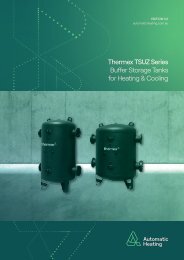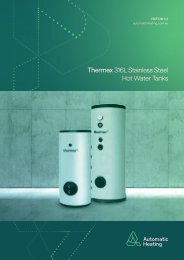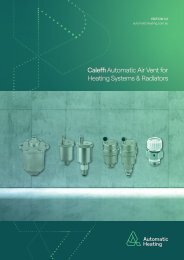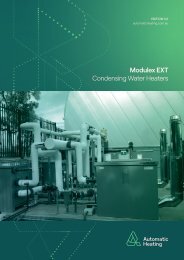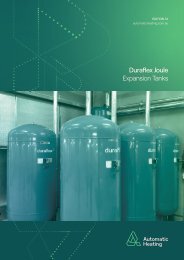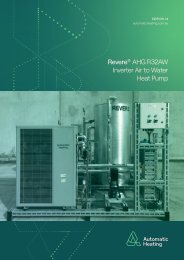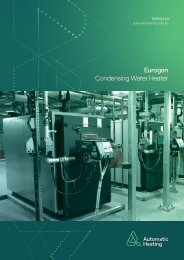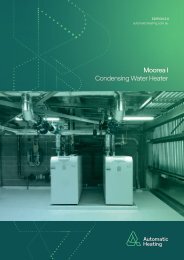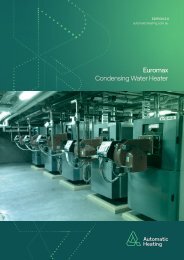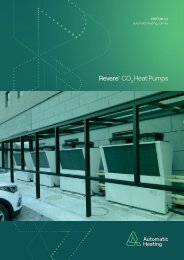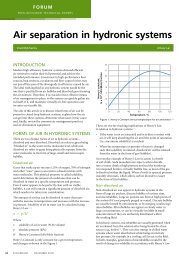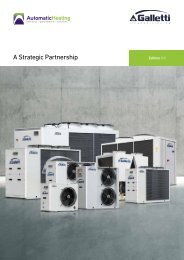AHG Solutions Guide_Edition 2.7
Full Product and Solutions Guide - Automatic Heating Global Pty Ltd
Full Product and Solutions Guide - Automatic Heating Global Pty Ltd
Create successful ePaper yourself
Turn your PDF publications into a flip-book with our unique Google optimized e-Paper software.
Condensate Neutralisers<br />
Condensate Neutralisers - HVAC Accessories<br />
Contents<br />
Condensate Neutralisers<br />
Over the last decade, the number of condensing boilers and water heaters being installed<br />
has continued to rise every year and all indications are that this trend will continue<br />
and eventually become mandatory due to their higher energy efficiency and cleaner<br />
emissions, compared to standard boilers.<br />
Condensing boilers discharge a corrosive condensate as a by-product of their operation. Because of the long-term effects of the<br />
sustained introduction of this corrosive condensate into drains and sewer lines, there is a growing awareness of the need to educate<br />
code enforcement officials, contractors, building owners, facility managers and homeowners of the need to neutralize this corrosive<br />
outflow and the means available to do this.<br />
HVAC ACCESSORIES<br />
What is Condensing Boiler condensate?<br />
Condensing water heaters achieve higher energy efficiency than<br />
standard boilers by condensing the water vapour in the flue gasses<br />
and using the latent energy recovered through this process to heat<br />
the return water going into the water heater. The condensing process<br />
is achieved by passing the piped hot flue gases through the cooler<br />
return water flowing back into the boiler. Flue gas starts to condense<br />
when it drops below its dew point of 55°C. This is why condensing<br />
boilers are designed to accommodate a return water temperature of<br />
54°C or less. It is this resulting condensate liquid that is acidic and<br />
requires treatment to avoid damage to piping systems, sewerage<br />
systems and other items it may come in contact with.<br />
How much condensate is produced?<br />
A general rule of thumb, 3.5 litres of condensate is produced<br />
for every 30kw of input providing the boiler is operating in full<br />
condensing mode. A boiler having 30kW of input operates for 1200<br />
hours annually will produce approximately 4200 litres of condensate.<br />
Acidity levels<br />
The acidic level of the condensate is measured as pH. Most<br />
condensate from natural gas appliances will have a pH of between<br />
2.0 and 4 with 7 being neutral. The actual pH will vary according<br />
to the actual chemical makeup of the fuel that is being burned.<br />
Condensate contains different types of acids that are corrosive to<br />
many materials and contain concentrations of nitric, nitrous, sulfuric,<br />
and sulfurous and hydrochloric acids. These acids can become<br />
more concentrated by repeated condensing and evaporation on heat<br />
exchangers and flues.<br />
A pH of 4 can damage drainage pipes, septic tanks, treatment plants<br />
and other materials handling waste water. The pH scale is not linear.<br />
Each whole number step below 7 is 10 times more acidic than the<br />
next higher number.<br />
How to Treat Condensate<br />
Treated condensate should be as close to 7 (neutral) as possible<br />
with 5 being the minimum. Most national and state codes prohibit<br />
anyone from allowing acidic liquid into a drainage system without<br />
treating it to raise its pH. To increase the pH to acceptable levels,<br />
whereby it no longer has the potential to damage the sewer system<br />
or environment, a condensate neutraliser should be installed.<br />
Condensate neutralisers are designed specifically for this task, and<br />
consist of a tank or module containing alkaline limestone aggregate<br />
or chips. Automatic Heating offers several models that accommodate<br />
water flow rates from 6.05l/hr to 155l/hr depending on the size of<br />
the condensing water heater system.<br />
2.9 - 4.0<br />
Flue Gas Condensate<br />
The acid is converted to water, carbon dioxide and mineral salts<br />
when exposed to the media. The carbon dioxide will generally stay<br />
diluted in the water and pass out of the neutralizer. The mineral<br />
salts generally settle at the bottom of the neutralizer. Over time the<br />
media dissolves and must be replenished. If applied properly and<br />
maintained regularly, damage associated with acidic condensate in<br />
the drain piping can be avoided.<br />
Condensate drains<br />
The condensate expelled from a condensing water heater is acidic<br />
with a pH of between 2 and 4, so it is critical that the appropriate<br />
materials are used in all piping where this liquid is present.<br />
In high temperature areas, like the flue, stainless steel must be<br />
used to prevent corrosion. The low temperature piping, such as that<br />
which drains the condensate from the heat exchanger condensate<br />
draining system, should be PVC or ABS to also mitigate corrosion.<br />
This system normally consists of a short length of PVC or ABS pipe<br />
with a water trap to prevent exhaust gases from being expelled into<br />
the drain and building.<br />
Maintenance & Servicing<br />
The best way to check if the condensate neutraliser is working<br />
properly is to test the treated condensate with a pH meter. pH<br />
meters are available at a reasonable cost and should be added to the<br />
technician’s tool arsenal. All manufacturers of condensing boilers<br />
recommend annual maintenance and the service technician should<br />
check and service the condensate neutralizer during this service.<br />
It is the responsibility of the plumbing professional to follow state<br />
and local plumbing codes including proper disposal of condensate<br />
and equally important for the end user to provide ongoing<br />
maintenance ensuring proper function of the unit. Damage can occur<br />
underground and in unseen, remote locations. Imagine digging up<br />
your basement floor to replace a rotted out metallic drain line!<br />
In Conclusion<br />
• Condensate from condensing boilers is acidic and corrosive to<br />
many materials and should be treated to maintain a pH of no less<br />
than 5 before disposal.<br />
• There can be a wide variation of the pH of condensate from<br />
condensing appliances due to the chemical make-up of the<br />
gas being combusted or from the way in which the appliance is<br />
operating in a particular application.<br />
• A fully condensing appliance will produce up to 3.5 litres of<br />
condensate per hour for every 30kw of input.<br />
• The neutraliser media is reacting with the solution to raise the pH<br />
and does need to be replaced. Most manufacturers recommend<br />
replacing media and checking operation at least annually.<br />
Typical Houshold<br />
Sewage<br />
1 2 3 4 5 6 7 8 9 10 11 12<br />
Battery Acid<br />
Gastric Acid<br />
Lemon<br />
Juice<br />
Vinegar<br />
Rain<br />
Water<br />
Clean Rain<br />
Water<br />
Distilled Water<br />
(Neutral)<br />
Tap<br />
Water<br />
Lake<br />
Water<br />
Ammonia<br />
ACIDIC<br />
BASIC<br />
260



